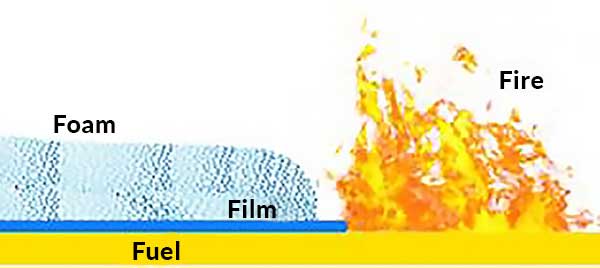By Darley Team
What is the latest with C8 Class B foams? Is there a safer alternative?—Asked by Ted Soldan, chief, Otter Lake (MI) Volunteer Fire and First Responders
Recent awareness of PFAS (per- & polyfluoroalkyl substances) environmental contamination is changing the Class B foam industry, and the fire industry should be aware of this issue.
PFAS is a broad term that includes all molecules that have a fluorine-carbon bond. They are often used as surfactants in Class B foam concentrates. Surfactants—with their hydrophilic (waterloving) head and a hydrophobic (water-hating) tail—are essential to the stability of foam. When bubbles are formed, the tails, repelled by the water, act as a buffer for the thin water membrane that is stabilized by the hydrophilic head. Without these molecular interactions, water bubbles would burst as quickly as bubbles blown under water. Foams for Class A (structure) fires, having always used carbon-loving surfactants without fluorine to soak into carbon fuel sources, are safe and biodegradable. The problem is Class B (flammable liquid) foams with carbon-hating fluorosurfactants (type of PFAS molecules) that allow foam to sit atop the liquid fuel and create an aqueous film that acts as a vapor barrier, cools the fuel, and helps spread the foam across the fuel to promote self-healing. The fluorine-carbon bonds in fluorosurfactants, while necessary for repelling hydrocarbon fuels, are extremely strong and take hundreds of years to degrade without incineration.
While not all PFAS chemicals are the same, two major components in older formulations of AFFF concentrates, perfluorooctane sulfonate (PFOS) and perfluorooctanoic acid (PFOA), have been found to be toxic and accumulate in living tissue for years. These PFOS and PFOA molecules are finding their way into groundwater and are being consumed by the public. Once these molecules are inside your body, they cause higher risks for high cholesterol; thyroid dysfunctions; birth defects; high blood pressure while pregnant; and even prostate, kidney, and testicular cancers.
Since 2002, when 3M found these effects in their fluorine-based foam, it has been a slow process to remove these fluorine molecules from AFFF, resulting in more than $670 million in lawsuits against foam manufacturers and regulations restricting AFFF within the coming years. Many foam manufacturers are now formulating fluorine-free foams (FFF) to provide an alternative solution. While FFFs are effective for fuel fires at thin depths, they are less effective when the fuel source has larger depths because of its lower resistance to hydrocarbon fuels compared to AFFF. Foams using shorter chain PFAS molecules have also been developed and are almost as effective as older formulations of AFFF. Older AFFF formulations used PFOS and PFOA molecules that consisted of 8 carbon chains (C8). Fluorosurfactants used in newer AFFF formulations use 6 carbon chain (C6) molecules that cannot break down into C8 molecules. While C6 fluorosurfactants are still toxic and persistent in the environment, it is believed they don’t accumulate in tissue like C8 molecules, resulting in a lower degree of long-term adverse effects than the C8 molecules cause.
Until more effective FFFs emerge, certain agencies have recommended that fire departments use current FFF when possible but resort to C6 foams when they have no other choice and always follow the foam manufacturers’ recommendations. As the foam industry changes, Darley is committed to keeping everyone aware of the changes occurring as it understands them, letting you know of developing technologies, and providing equipment designed for the safest possible outcome.
For more information, visit www.darley.com.






